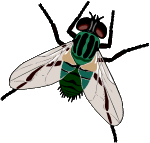Forensic Entomology
 On a warm sunny day, insects are often the first individuals to arrive at the scene of a violent crime. Within minutes of death, blow flies (family Calliphoridae) are attracted to the fresh corpse and begin laying eggs in open wounds and body cavities (e.g., eyes, nose, and mouth). The eggs hatch in 1-3 days and young larvae (maggots) grow rapidly as they feed on the soft tissues of the corpse. Since each Calliphorid species has a characteristic temperature-dependent growth rate, the larvae can be regarded as a biological stopwatch that starts ticking shortly after the victim dies. Forensic entomologists learn to read this stopwatch by determining which insect species are present and how far they have progressed toward adulthood. With good records of ambient temperature, the post-mortem interval (time elapsed since death) can be calculated to within a few hours, even when death may have occurred 2-3 weeks previously.
On a warm sunny day, insects are often the first individuals to arrive at the scene of a violent crime. Within minutes of death, blow flies (family Calliphoridae) are attracted to the fresh corpse and begin laying eggs in open wounds and body cavities (e.g., eyes, nose, and mouth). The eggs hatch in 1-3 days and young larvae (maggots) grow rapidly as they feed on the soft tissues of the corpse. Since each Calliphorid species has a characteristic temperature-dependent growth rate, the larvae can be regarded as a biological stopwatch that starts ticking shortly after the victim dies. Forensic entomologists learn to read this stopwatch by determining which insect species are present and how far they have progressed toward adulthood. With good records of ambient temperature, the post-mortem interval (time elapsed since death) can be calculated to within a few hours, even when death may have occurred 2-3 weeks previously.
 In addition to post-mortem interval, fly larvae can also reveal other important information about a crime:
In addition to post-mortem interval, fly larvae can also reveal other important information about a crime:
- Wounds — blow fly larvae cannot penetrate undamaged skin. An infestation inside the chest or abdomen would suggest the possibility of a bullet hole or a stab wound.
- Movement — Since local conditions (e.g. sun or shade, urban or rural) affect which species will colonize a corpse, it may be possible to determine whether or not a body has been moved since its death.
- Toxicology — drugs or toxins from a corpse may be detectable in fly larvae even after the body tissues are too decomposed for standard toxicological tests.
 As a body continues to decay, it goes through successive stages of decomposition. Each stage is associated with a distinctive type of insect fauna. The exact species are likely to vary from country to country and season to season, but the general pattern of succession is still consistent enough to give forensic scientists a rough estimate of post-mortem interval. In general, a fresh corpse (1-3 days) has many blow fly eggs and only a few small larvae. As bacteria and other microorganisms begin to grow in the moribund tissues they produce gas which fills the body cavities and causes the carcass to inflate. This bloat stage lasts until the fly maggots penetrate body cavities and release the gas (3-5 days). Once the carcass collapses, it enters a period of active decay. Maggots, flies, ants, and carrion beetles are abundant. After most of the flesh has been consumed, the corpse enters a stage of advanced decay. The insect fauna becomes fewer in number but there is greater species diversity: carpet beetles, ants, skipper flies, and mites are common. Eventually the corpse becomes dry and skeletonized, but ants and mites may continue to live in the bones for 2-3 years.
As a body continues to decay, it goes through successive stages of decomposition. Each stage is associated with a distinctive type of insect fauna. The exact species are likely to vary from country to country and season to season, but the general pattern of succession is still consistent enough to give forensic scientists a rough estimate of post-mortem interval. In general, a fresh corpse (1-3 days) has many blow fly eggs and only a few small larvae. As bacteria and other microorganisms begin to grow in the moribund tissues they produce gas which fills the body cavities and causes the carcass to inflate. This bloat stage lasts until the fly maggots penetrate body cavities and release the gas (3-5 days). Once the carcass collapses, it enters a period of active decay. Maggots, flies, ants, and carrion beetles are abundant. After most of the flesh has been consumed, the corpse enters a stage of advanced decay. The insect fauna becomes fewer in number but there is greater species diversity: carpet beetles, ants, skipper flies, and mites are common. Eventually the corpse becomes dry and skeletonized, but ants and mites may continue to live in the bones for 2-3 years.

